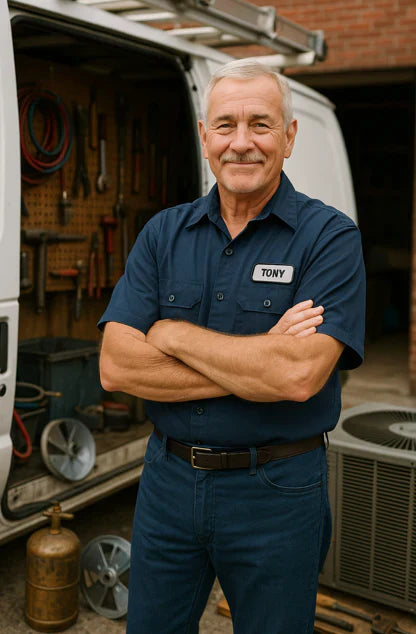👀 If you’re short on space but still want powerful cooling, a self-contained AC unit could be your HVAC hero. Tony the Trusted Tech breaks down what makes these systems tick and when they make sense—especially compared to traditional setups like the 2.5 Ton 14.5 SEER2 Air Conditioner and Air Handler System.
What Is a Self-Contained AC Unit, Anyway?
Let’s start simple. A self-contained AC unit is exactly what it sounds like—a single HVAC unit that houses all the components needed for cooling. That means the compressor, condenser, evaporator coil, and blower are all tucked into one cabinet. No separate indoor and outdoor units. No running refrigerant lines between parts. It’s plug-and-play cooling in one compact box.
⚙️ Common Names for Self-Contained Systems:
✔️ Packaged AC units
✔️ Rooftop units (RTUs)
✔️ Through-the-wall air conditioners (for smaller residential uses)
✔️ PTAC units (found in hotels and apartments)
💡 These are ideal in places where there’s just no room (or budget) for a traditional split system.
Self-Contained vs. Split Systems: What’s the Difference?
⁉️ I get this question a lot. “Tony, should I go with a self-contained AC unit or a split system like the 2.5 Ton 14.5 SEER2 R-32 Air Conditioner and Air Handler System?”
Here’s how they compare:
| Feature | Self-Contained AC | Split System |
|---|---|---|
| Installation | Quick, single-unit install | Requires indoor & outdoor units |
| Space Needed | Minimal (can go on roof or pad) | Needs indoor and outdoor space |
| Efficiency | Generally lower SEER ratings | Higher SEER options available |
| Noise | Can be louder inside if located indoors | Quieter indoors (air handler is inside) |
| Maintenance | Easier with access to one cabinet | Requires servicing two separate units |
In short, if you're after simplicity and fast installation, a self-contained air conditioning unit can be a great pick. But for energy efficiency, zoning, and quieter operation, you can't beat a split system like our Goodman 2.5 Ton 14.5 SEER2 R-32 setup.
Where Do Self-Contained AC Units Make Sense?
These systems are especially useful in:
✔️ Mobile homes
✔️ Rooftop commercial setups
✔️ Tiny homes or prefab cabins
✔️ Add-on structures like garages or workshops
✔️ Retrofits where ductwork just isn’t feasible
In fact, the U.S. Department of Energy notes that packaged terminal air conditioners (a type of self-contained unit) can be a smart fit for individual room control and space savings.
Are Self-Contained AC Units Efficient?
Here’s the honest truth—they’re not as efficient as split systems, especially not high-SEER options like the 14.5 SEER2 models that use modern refrigerants like R-32. But if you're working within constraints—like no ductwork, no attic space, or budget limitations—they get the job done reliably.
Want to keep your energy bills in check? Look for units with Energy Star ratings and variable-speed fans. While the upfront SEER rating might be lower, advanced features can help offset the difference.
Learn more about SEER2 and efficiency from AHRI.
Self-Contained AC Maintenance: Easier but Still Essential
Just because it's all-in-one doesn’t mean it’s maintenance-free. You still need to:
✔️ Replace filters regularly
✔️ Keep coils clean
✔️ Inspect drain lines for clogs
✔️ Make sure the fan motor is running smoothly
💭 Final Thoughts from Tony 💭
A self-contained AC unit can be the perfect solution for folks who need simplicity, space savings, and fast install times. But it’s not a one-size-fits-all answer. If you’re planning for long-term comfort and efficiency, I still recommend looking into traditional split systems—like this 2.5 Ton Goodman System with 14.5 SEER2 and R-32. It's built for modern comfort and environmental responsibility.
🎯 At the end of the day, the best system is the one that fits your space, budget, and comfort goals.
🛠️ From my toolbelt to your thermostat, stay comfortable
--Tony 🛠️







